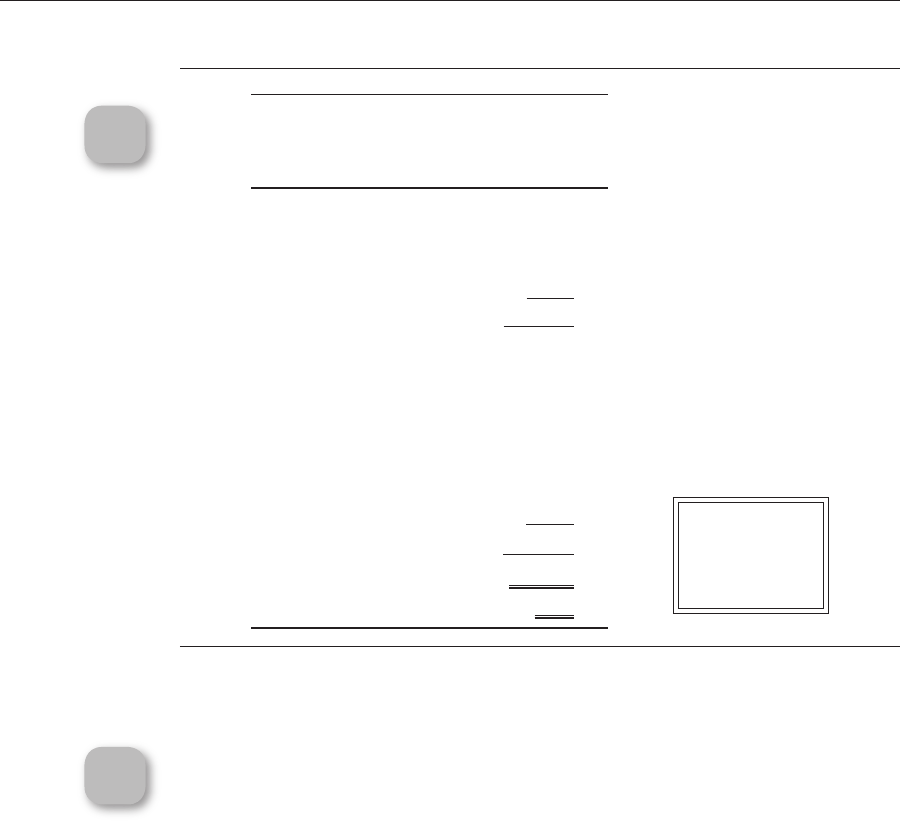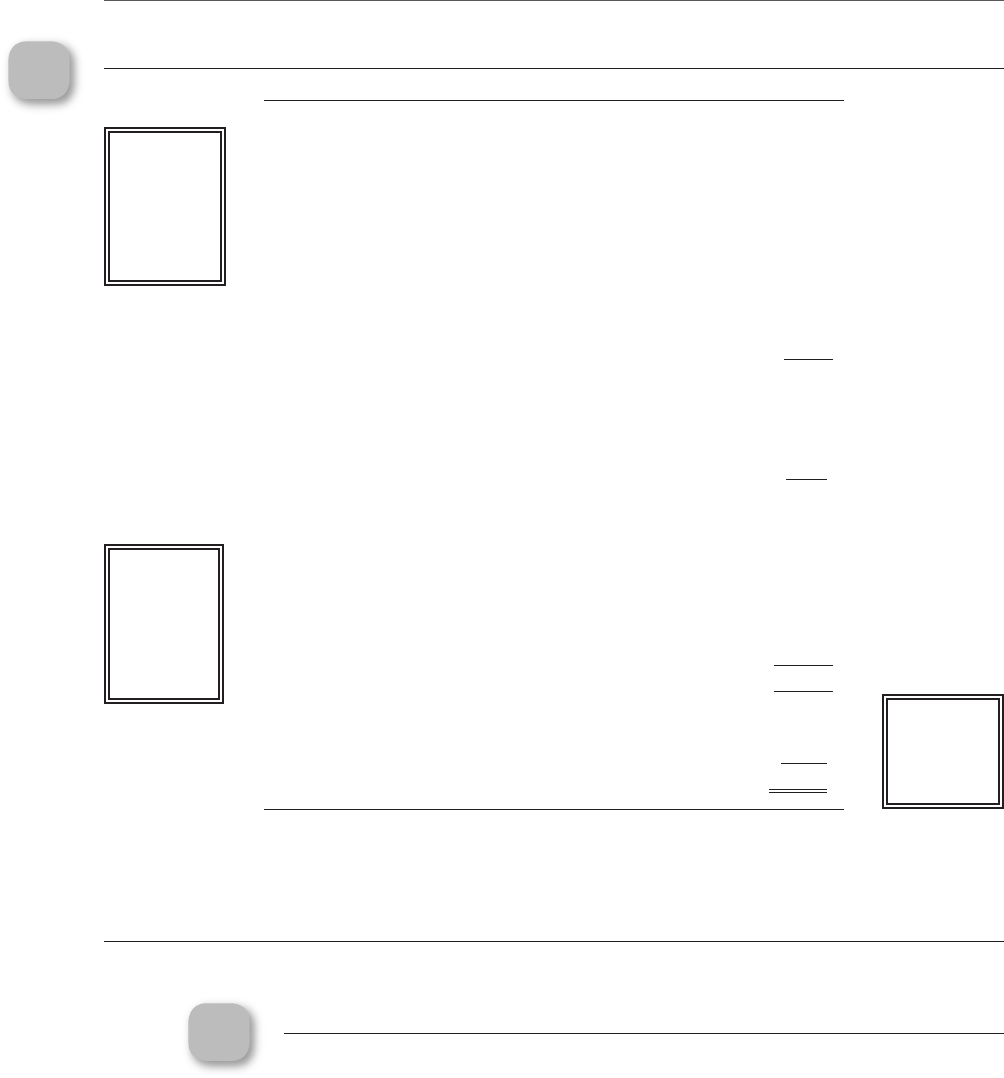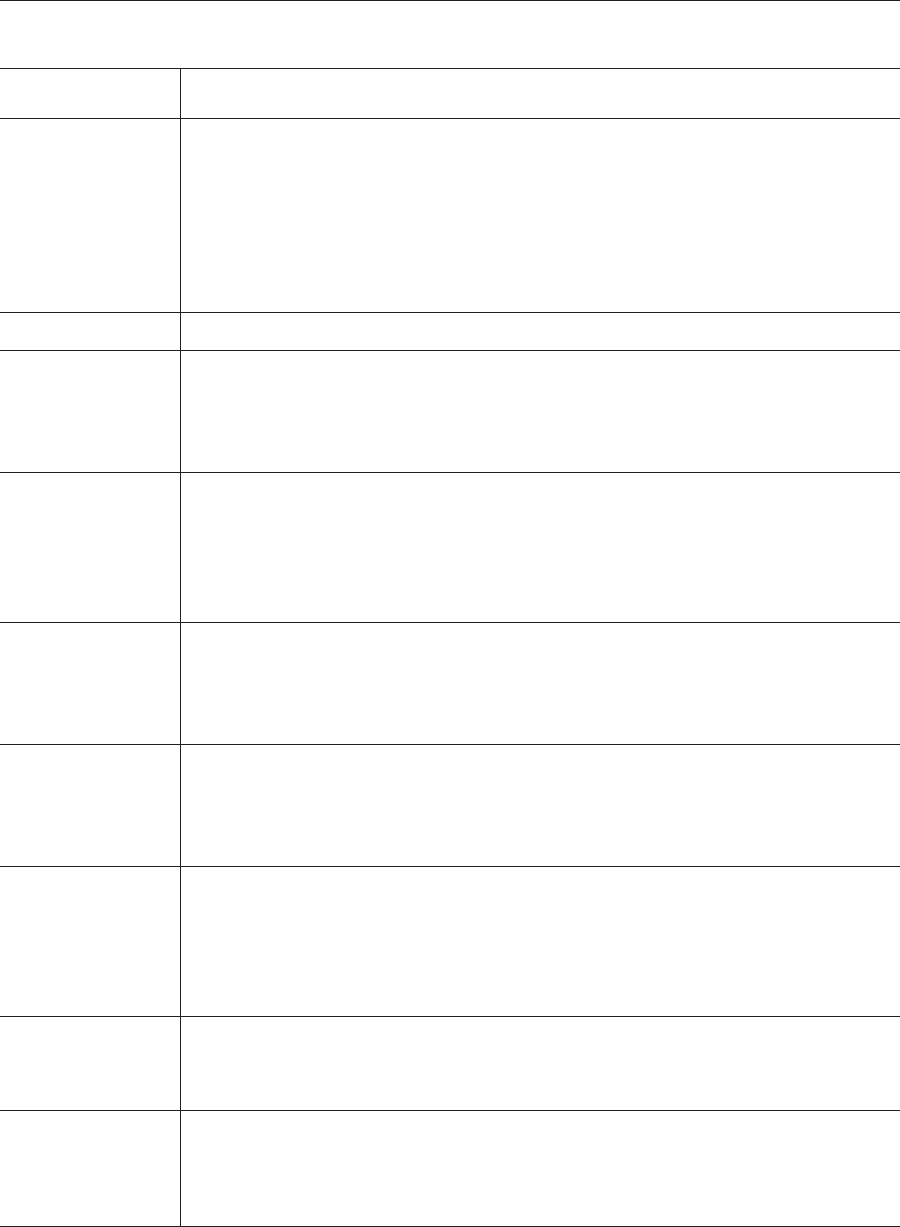
25
Financial Statements
T
in this topic are required by the
Securities and Exchange Commission (SEC) for all publicly traded companies
and are a useful tool for presenting a basic nancial picture of any company. e
four required nancial statements include the income statement, the statement of
changes in equity, the balance sheet, and the statement of cash ows.
e four nancial statements are integrally related. e balance sheet is
connected to the income statement (net income) through the change in retained
earnings shown in the statement of changes in shareholders’ equity. e balance
sheet change in cash and other changes in nancial position are presented in the
statement of cash ow. Changes in capital received in the balance sheet are shown
in the statement of changes in shareholders’ equity.
e way in which various nancial transactions a ect the elements of each of
the nancial statements and the proper classi cation of the various nancial trans-
actions is covered in Topic 2: Recognition, Measurement, Valuation, and Disclosure.
e nancial statements shown in this topic are all for a ctitious organi-
zation, Robin Manufacturing Company, for a given year, and linkages between
the various statements are illustrated with notes and by the amounts themselves.
e footnotes to nancial statements, which present required disclosures, are
also covered.
Most entities provide prior years’ nancial statement information next to
the current year’s information for comparison. For example, income and cash
ow statements usually show the results of three consecutive years, which allows
analysts to compare past performance to present performance and make a deter-
mination of future success.
LOS
§1.A.1.g
LOS
§1.A.1.e
READ the Learning Outcome Statements (LOS) for this topic as found in
Appendix A and then study the concepts and calculations presented here
to be sure you understand the content you could be tested on in the CMA
exam.
TOPIC 1
c01.indd 25 30-05-2015 13:53:19
COPYRIGHTED MATERIAL

26 CMAexcel Self-Study Part 1: Financial Reporting, Planning, Performance, and Control
is topic ends with a discussion of the needs of external users and how nan-
cial statements satisfy some of those needs.
Income Statement
e income statement, commonly called a prot and loss (P&L) statement, measures
the earnings of an entity’s operations over a given period of time, such as a quarter
or a year. e income statement is used to measure protability, creditworthiness,
and investment value of an entity, and along with the other statements, it helps
assess the amounts, timing, and uncertainty of future cash ows.
Income and Other Comprehensive Income
e nancial statement elements reported on the income statement are revenues,
expenses, gains, and losses. Financial Accounting Standards Board (FASB) Accounting
Standards Codication (ASC) Topic 220, Comprehensive Income (formerly SFAS No.
130), requires rms to report certain unrealized gains and losses outside of net income
as components of other comprehensive income. Comprehensive income is the sum
of net income plus (or minus) the items of other comprehensive income.
Firms have the option of presenting the calculation of comprehensive income
either as part of an income statement (appended at the end) or as a separate
statement of comprenhensive income. Comprehensive income can no longer be
presented as a part of the statement of shareholders’ equity.
Format of Financial Information
e two most common formats are single-step income statements and multiple-
step income statements.
Single-Step Income Statement
A single-step income statement subtracts total expenses and losses from total rev-
enues and gains in a single step. No attempt is made to categorize expenses and
revenues or to arrive at interim subtotals. However, despite the inherent simplicity
of the single-step income statement, the multiple-step income statement is cur-
rently more popular.
Figure 1A-1 shows a single-step income statement for Robin Manufacturing
Company, Year 1.
LOS
§1.A.1.b
c01.indd 26 30-05-2015 13:53:19

Section A, Topic 1—Financial Statements 27
Multiple-Step Income Statement
e multiple-step income statement separates information into operating and nonop-
erating categories. e sections in the statement that do not relate to operating cash
ows are called other revenues and gains and other expenses and losses. ese catego-
ries could include gains and losses from the sale of equipment, interest revenue and
expense, or dividends received.
e multiple-step income statement has subcategories, such as cost of goods
sold (COGS); operating (selling and administrative) expenses; and other revenues,
expenses, gains, and losses. ese subcategories allow users to compare a compa-
ny’s results over time or with those of a competitor to determine the eciency with
which the entity’s scarce resources are used. Such comparisons are especially valu-
able when several years’ income statements are compared.
e multiple-step income statement oen reports subtotals for gross prot and
income from operations, which are useful for nancial statement analysis purposes.
For example, gross prot can be used to compare how competitive pressures have
aected prot margins.
Figure 1A-2 shows a multiple-step income statement.
LOS
§1.A.1.c
Figure 1A-1 Single-Step Income Statement
Robin Manufacturing Company
Income Statement
for the Year Ended December 31, Year 1
Revenues
Net sales $2,734,620
Dividend revenue 90,620
Rental revenue 67,077
Total revenues 2,892,317
Expenses
Cost of goods sold 1,823,938
Selling expenses 416,786
Administrative expenses 322,709
Interest expense 115,975
Income tax expense 61,579
Total expenses 2,740,987
Net income $151,330
Earnings per common share $1.89
To statement
of changes in
equity section
(Figure 1A-4)
→
LOS
§1.A.1.h
c01.indd 27 30-05-2015 13:53:19

28 CMAexcel Self-Study Part 1: Financial Reporting, Planning, Performance, and Control
Figure 1A-2 Multiple-Step Income Statement
Robin Manufacturing Company
Income Statement for the Year Ended December 31, Year 1 (Y1)
Sales Revenue
Sales $2,808,835
Less: Sales discounts $22,302
Less: Sales returns and allowances
51,913 74,215
Net sales revenue 2,734,620
Cost of Goods Sold
Merchandise inventory, Jan. 1, Y1 424,321
Purchases $1,830,518
Less: Purchase discounts
17,728
Net purchases 1,812,790
Freight and transportation—in
37, 363 1,850,153
Total merchandise available for sale 2,274,474
Less: Merchandise inventory, Dec. 31, Y1
450,536
Cost of goods sold $1,823,938
Gross profit on sales 910,682
Operating Expenses
Selling expenses
Sales salaries and commissions 186,432
Sales office salaries 54,464
Travel and entertainment 45,025
Advertising expense 35,250
Freight and transportation—out 37,912
Shipping supplies and expense 22,735
Postage and stationery 15,445
Depreciation of sales equipment 8,285
Telephone and Internet expense
11,238 416,786
Administrative expenses
Officers’ salaries 171,120
Office salaries 56,304
Legal and professional services 21,823
Utilities expense 21,413
Insurance expense 15,667
Building depreciation 16,614
Office equipment depreciation 14,720
Stationery, supplies, and postage 2,645
Miscellaneous office expenses
2,403 322,709 739,495
Income from operations 171,187
Other Revenues and Gains
Dividend revenue 90,620
Rental revenue
67,077 157,697
328,884
Other Expenses and Losses
Interest on bonds and notes 115,975
Income before income tax 212,909
Income tax 61,579
Net income for the year $151,330
Earnings per common share $1.89
LOS
§1.A.1.h
→
To statement
of change in
equity
(Figure 1A-4)
c01.indd 28 30-05-2015 13:53:19

Section A, Topic 1—Financial Statements 29
Additional Income Statement Presentation Items
Occasionally, companies will experience an event that requires separate reporting
below income from continuing operations. Additional items that may be located
at the end of the income statement include discontinued operations and extraor-
dinary items.
• Discontinued operations. When an entity disposes of a business component
that has clearly distinguishable operations and cash ows the item is recorded
in a separate section of the income statement aer continuing operations and
before extraordinary items. Discontinued operations are shown net of tax.
• Extraordinary items. Material items that are both unusual in nature and infre-
quent in occurrence also require a separate section in the income statement
and are shown net of tax.
Figure 1A-3 shows how net income is determined when these items are included.
Figure 1A-3 Multistep Income Statement with Additional Income Statement Items
Statements of Change in Equity
When a balance sheet is issued, the FASB requires disclosure of the changes in
each separate shareholder’s equity account. is requirement satises the FASB’s
suggestion that complete nancial statements should include investments by and
distributions to owners during the period. e required statements of change in
equity is intended to help external users assess how changes in the company’s
nancial structure may aect its nancial exibility.
Major Components and Classifications
Shareholders’ equity includes several components: capital stock (par value of
preferred and common shares), additional paid-in capital, retained earnings, and
LOS
§1.A.1.b
LOS
§1.A.1.c
Net sales
− Cost of goods sold
Gross profit on sales
− Operating expenses
Operating income
+/− Other gains and losses
Earnings before tax
− Tax expense
Income from continuing operations
+/− Discontinued operations
+/− Extraordinary items
+/− Changes in accounting principle
Net income
c01.indd 29 30-05-2015 13:53:19

30 CMAexcel Self-Study Part 1: Financial Reporting, Planning, Performance, and Control
accumulated other comprehensive income. Capital stock is the par value (or face
value) for the shares, and additional paid-in capital is the amount paid for the shares
in excess of par. us, these two categories combine to form contributed capital, also
called paid-in capital. Retained earnings can be subdivided into general earnings
retained for company use and appropriated earnings set aside for some purpose.
Format of Financial Information
e statement of changes in equity usually lists information in the following order:
• Beginning balance for the period
• Additions
• Deductions
• Ending balance for the period
Figure 1A-4 shows a sample statement of changes in equity. is example shows
the statement listed in a columnar format for a company with only common stock
outstanding.
Balance Sheet
e balance sheet (sometimes called a statement of nancial position) is an essential
tool in assessing the amounts, timing, and uncertainty of prospective cash ows. It
is referred to as the balance sheet because of the balance expressed by the accounting
equation:
Assets = Liabilities + Shareholders’s Equity
LOS
§1.A.1.b
Figure 1A-4 Statement of Changes in Equity
Robin Manufacturing Company
Schedule of Changes in Shareholders’ Equity
for Year Ended December 31, Year 1 (Y1)
Common
Stock,
$1 Par
Additional
Paid-In
Capital
Retained
Earnings Total
Balance, Jan. 1, Y1
$24,680
$345,520 $90,251 $460,451
Net income 151,330 151,330
Cash dividends paid (33,330) (33,330)
Common stock
issued
1,000
14,800 15,800
Balance, Dec. 31, Y1
$25,680 $360,320 $208,251 $594,251
LOS
§1.A.1.h
From
income
statement
(Figures
1A-1 and
1A-2)
→
To balance
sheet
(Figure 1A- 6)
→
c01.indd 30 30-05-2015 13:53:19

Section A, Topic 1—Financial Statements 31
Alternatively, the accounting equation can tell us that equity equals assets less
liabilities, which is also known as net assets. e balance sheet provides a snapshot
of the company’s assets and the claims on those assets at a specic point in time.
While the balance sheet does not claim to show the value of the entity, it should
allow external users to make their own estimates of the entity’s value when used
in conjunction with the other nancial statements and other relevant information.
e balance sheet helps users evaluate the capital structure of the entity and
assess the entity’s liquidity, solvency, nancial exibility, and operating capability.
e balance sheet is also essential in understanding the income statement
because revenues and expenses reect changes in assets and liabilities, so an ana-
lyst must evaluate both statements together.
Major Components and Classifications
e balance sheet is divided into three sections: assets, liabilities, and shareholders’
equity. ese classications are designed to group similar items together so they can
be analyzed more easily. Assets are listed with the most liquid items rst and the least
liquid last. Liabilities are listed in the order in which they become due. In the case of
equity, the items that have most claim to the equity are listed before items with less
claim. Figure 1A-5 summarizes the general subdivisions of each category.
LOS
§1.A.1.c
Figure 1A-5 Balance Sheet Components
Assets Current assets (cash, accounts receivable
[A/R], inventory, etc.)
Long-term investments
Property, plant, and equipment (PP&E)
Intangible assets (patents, goodwill,
etc.)
Other assets
Liabilities Current liabilities (accounts payable [A/P],
interest payable, current portion of long-
term debt, etc.)
Long-term liabilities (bonds,
mortgages, etc.)
Other liabilities
Shareholders’ equity Capital stock
Treasury stock (contra equity)
Additional paid-in capital
Accumulated other comprehensive
income
Retained earnings
e components of assets, liabilities, and equity are more thoroughly discussed
in Topic 2 of this section.
Format of Financial Information
e two most common formats for the balance sheet are the account form and
the report form. All styles of balance sheets break down the assets, liabilities, and
shareholders’ equity into the categories listed in Figure 1A-5 (current assets, etc.).
e account form lists assets on the le side and liabilities and shareholders’ equity
c01.indd 31 30-05-2015 13:53:19

32 CMAexcel Self-Study Part 1: Financial Reporting, Planning, Performance, and Control
on the right side. e report form, shown in Figure 1A-6, lists assets at the top and
liabilities and shareholders’ equity at the bottom. Outside the United States, other
balance sheet formats are used, such as the nancial position form, which deducts
current liabilities from current assets to show working capital.
In Figure 1A-6, the assets and liabilities are also categorized by their levels of
nancial exibility. For example, current assets are shown separately from xed
assets.
Figure 1A-6 Balance Sheet
Robin Manufacturing Company
Balance Sheet
December 31, Year 1
Assets
Current assets:
Cash and short-term investments $24,628
Trade receivables, net of $30K allowance 552,249
Other receivables 18,941
Note receivable—related party 80,532
Inventory 252,567
Prepaid insurance 7,500
Total current assets 936,417
Fixed assets:
Property and equipment 209,330
Less: Accumulated depreciation (75,332)
Net fixed assets 133,998
Total assets $1,070,415
Liabilities and Equity
Current liabilities
Accounts payable $175,321
Accrued expenses 2,500
Current portion of long-term debt 36,000
Line of credit 145,000
Total current liabilities 358,821
Long-term debt 117,343
Total current and long-term liabilities 476,164
Shareholders’ equity:
Common stock, par 25,680
Additional paid-in capital 360,320
Retained earnings 208,251
Total shareholders’ equity 594,251
Total liabilities and shareholders’ equity $1,070,415
LOS
§1.A.1.h
From
statement
of change
in equity
(Figure 1A- 4)
→
→
→
→
c01.indd 32 30-05-2015 13:53:20

Section A, Topic 1—Financial Statements 33
Statement of Cash Flows
Cash is a company’s most liquid resource, and therefore it aects liquidity, operating
capability, and nancial exibility. FASB ASC Topic 230, Statement of Cash Flows
(formerly SFAS No. 95), says that a statement of cash ows “must report on a
company’s cash inows, cash outows, and net change in cash from its operating,
nancing, and investing activities during the accounting period, in a manner that
reconciles the beginning and ending cash balances.” e statement helps interested
parties determine if an entity needs external nancing or if it is generating positive
cash ows to meet its obligations and pay dividends. Keep in mind that a company
could have high income but still have negative cash ow.
Components and Classifications
Cash receipts and cash payments are classied in the statement of cash ows as
related to operating, investing, or nancing activities.
Operating Activities
Cash ows from operating activities are those related to the normal course of
business. Any transaction that does not qualify as an investing or nancing
activity is included in the operating activity section. Examples of cash inows
include cash receipts from sales of any kind, collection of A/R, collection of
interest on loans, and receipts of dividends. Cash outows include cash paid to
employees, suppliers, and the Internal Revenue Service (IRS) and to lenders for
interest.
Statements that are compliant with generally accepted accounting principles
(GAAP) use accrual accounting, so net income includes noncash revenues (e.g.,
uncollected credit sales) and noncash expenses (e.g., unpaid expenses). Other
items that are included in accrual accounting are depreciation, depletion, amorti-
zation, and other costs that were incurred in prior periods but are being charged
to expenses in the current period. ese items reduce net income but do not aect
cash ows for the current period. erefore, these items are added back when deter-
mining net cash ow from operating activities.
Examples of noncash expense and revenue items that must be added back to
net income include those listed next.
• Depreciation expense and amortization of intangible assets
• Amortization of deferred costs, such as bond issue costs
• Changes in deferred income taxes
• Amortization of a premium or discount on bonds payable
• Income from an equity method investee
To determine operating cash ows, FASB ASC Topic 230, Statement of Cash
Flows, allows entities to use either the indirect method or the direct method.
LOS
§1.A.1.b
LOS
§1.A.1.c
c01.indd 33 30-05-2015 13:53:20

34 CMAexcel Self-Study Part 1: Financial Reporting, Planning, Performance, and Control
Indirect Method
e indirect method, or reconciliation method, is the most popular method of con-
verting net income to net cash ow from operating activities. It starts with net
income and then adjusts it by adding back noncash expenses and paper losses and
subtracting noncash revenues and paper gains that have no eect on current period
operating cash ows. Additional adjustments are made for changes in current asset
and liability accounts related to operations by adding or subtracting amounts, as
shown in Figure 1A-7. For example, an increase in A/R (a current asset) would be
subtracted from net income to arrive at operating cash ows because it means that
the amount of cash collected from customers is less than the amount of accrual rev-
enue reported. See Figure 1A-7 for an example of the indirect method.
Figure 1A-7 Cash Flows from Operating Activities—Indirect Method
LOS
§1.A.1.h
Net income
+ Noncash expenses (typically depreciation and amortization expenses)
− Gains from investing and financing activities
+ Losses from investing and financing activities
+ Decreases in current assets
− Increases in current assets
+ Increases in current liabilities
− Decreases in current liabilities
+ Amortization of discounts on bonds
− Amortization of premiums on bonds
Operating cash flow
Direct Method
In the direct method, or income statement method, net cash provided by operating
activities is calculated by converting revenues and expenses from the accrual basis
to the cash basis. Although the FASB encourages the use of the direct method, it is
rarely used. Furthermore, if the direct method is used, the FASB requires that the
reconciliation of net income to net cash ow from operating activities be disclosed in
a separate schedule. Figure 1A-8 shows how a direct method statement is arranged.
(e gure includes sample amounts for illustration.)
Investing Activities
Most items in the investing activities section come from changes in long-term asset
accounts. Investing cash inows result from sales of PP&E, sales of investments in
another entity’s debt or equity securities, or collections of the principal on loans to
another entity. (Interest is included in operating cash ows.) Investing cash outows
c01.indd 34 30-05-2015 13:53:20

Section A, Topic 1—Financial Statements 35
result from purchases of PP&E, purchases of other companies’ debt or equity secu-
rities, and the granting of loans to other entities.
Financing Activities
Most items in the nancing activities section come from changes in long-term lia-
bility or equity accounts. Financing cash inows come from the sale of the entity’s
equity securities or issuance of debt, such as bonds or notes. Cash outows consist
of payments to stockholders for dividends and payments to reacquire capital stock
or redeem a company’s outstanding debt. In other words, investing activities involve
the purchase or sale of xed assets and investments in another company’s securi-
ties, while nancing activities involve the issuance and redemption of a company’s
own equity and debt securities.
Footnotes
e statement of cash ows requires footnote disclosure of any signicant noncash
investing and nancing activities, such as the issuing of stock for xed assets or
the conversion of debt to equity. In addition, when the indirect method for cash
ow from operations is used, both interest paid and income taxes paid need to be
disclosed.
Example of a Statement of Cash Flows
e statement of cash ows shown in Figure 1A-9 illustrates the more commonly
used indirect approach for calculating operating cash ows. Cash ows from each
category (operating, investing, and nancing) are separately classied and totaled.
e sum of cash inows (or outows if negative) from these three categories equals
the net increase or decrease in cash for the period. is net cash inow (outow) is
added to (subtracted from) the cash balance at the beginning of the year to obtain
the cash balance at the end of the year (highlighted in gray). us the cash ow
statement explains the net change in the amount of cash and cash equivalents
(short-term, highly liquid investments that are close to maturity) from the begin-
ning to the ending balance sheet.
Figure 1A-8 Cash Flows from Operating Activities—Direct Method
Cash received from customers $100,000
Cash paid to suppliers (40,000)
Cash paid for interest (5,000)
Cash paid for taxes (10,000)
Cash paid for operating expenses (25,000)
Cash provided by operating activities $20,000
c01.indd 35 30-05-2015 13:53:20

36 CMAexcel Self-Study Part 1: Financial Reporting, Planning, Performance, and Control
Figure 1A-9 Statement of Cash Flows—Indirect Method
Operating Activities
Net income $151,330
Adjustments to convert net income to a cash basis:
Depreciation and amortization charges* 75,332
Decrease (increase) in accounts receivable (31,445)
Increase (decrease) in merchandise inventory (4,165)
Increase (decrease) in accounts payable 6,740
Increase (decrease) in accrued wages and salaries payable 4,543
Increase (decrease) in accrued income taxes payable 3,984
Increase (decrease) in deferred income taxes (4,950)
Gain on sale of store
†
(1,255)
Net cash provided by operating activities 200,114
Investing Activities
Additions to property, buildings, and equipment (123,730)
Proceeds from sale of store
3,980
Net cash used in investing activities (119,750)
Financing Activities
Increase (decrease) in notes payable 1,100
Increase (decrease) in additional paid-in capital 14,800
Increase (decrease) in long-term debt (50,500)
Increase (decrease) in common stock 1,000
Cash dividends paid
(33,330)
Net cash used in financing activities
(66,930)
Net increase in cash and cash equivalents 13,434
Cash and cash equivalents at beginning of year 11,194
Cash and cash equivalents at end of year
$24,628
Note: Changes in various asset and liability accounts (e.g., increases/decreases) can be
obtained by comparing two consecutive years’ balance sheets.
* Depreciation and amortization charges are included in the income statement as part
of administrative expenses.
†
Gain on sale of store is included in the income statement as part of other revenue.
LOS
§1.A.1.h
From
income
statement
(Figures
1A-1 and
1A-2)
→
From
statement
of change
in equity
(Figure
1A-4)
→
→
→
To balance
sheet
(Figure
1A-6)
→
Limitations of the Financial Statements
e following items describe the limiting characteristics of nancial statements.
• Historical cost. Most asset accounts of a nonnancial nature are reported at
historical cost. While historical cost measures are considered reliable because
the amounts can be veried, they are also considered less relevant than fair
value or current market value measures would be for assessing a rm’s current
nancial position.
• Dierent accounting methods. Employing dierent accounting methods will
yield dierent net incomes. Each choice of two or more accounting methods
LOS
§1.A.1.d
c01.indd 36 30-05-2015 13:53:20

Section A, Topic 1—Financial Statements 37
will further change the results reported, making the task of comparing dier-
ent entities very dicult, even when these methods are disclosed.
• Omit nonobjective items of value. Financial statements exclude valuable assets
that are of nancial importance but cannot be objectively expressed in num-
bers. For example, the value of human resources, intangibles such as brand
recognition and reputation, or the value of the entity’s customer base cannot
be exactly or reliably estimated, so they are not included on the balance sheet.
erefore, the balance sheet does not pretend to measure the value of the com-
pany as a whole.
• Use of estimates and judgments. Financial statements incorporate the use of
numerous estimates and professional judgments. Dierences in estimates mean
that the income statements for two or more entities may be dicult to compare.
Common estimates include the amount of receivables allocated to an allow-
ance for doubtful accounts and the useful life and salvage value of a piece of
equipment.
•O–balance sheet information. Transactions may be recorded in a way that
avoids reporting liabilities and assets on the balance sheet, for example, with
an operating lease. e Sarbanes-Oxley Act of 2002 (SOX) requires publicly
traded rms to disclose o–balance sheet information in their lings with
the SEC.
• Noncash transactions. e statement of cash ows omits noncash transactions,
such as the exchange of stock for a property, exchanges of nonmonetary assets,
conversion of preferred stock or debt to common stock, or issuing equity secu-
rities to retire a debt. Disclosure of any noncash transactions that aect assets
or liabilities would be reported in a note or a supplemental schedule.
Footnotes/Disclosures to Financial Statements
Footnotes or disclosures to nancial statements are used when parenthetical expla-
nations would not suce to describe situations particular to the entity. Typical
disclosures include contingencies, contractual situations, accounting policies, and
subsequent events.
Contingencies
Contingencies are material events with an uncertain outcome dependent on the
occurrence or nonoccurrence of one or more future events. Contingencies can be
either gain contingencies or loss contingencies. Income recognition is not given to
gain contingencies; however, loss contingencies must be recognized when it is both
probable that a loss has been incurred and the amount of the loss is reasonably esti-
mable. Other material loss contingencies should be disclosed in the footnotes to the
nancial statements; gain contingencies may also be disclosed.
Loss contingencies result from situations such as pending litigation, war-
ranty and premium costs, environmental liabilities, and self-insurance risks. Gain
LOS
§1.A.1.f
c01.indd 37 30-05-2015 13:53:20

38 CMAexcel Self-Study Part 1: Financial Reporting, Planning, Performance, and Control
contingencies result from pending litigation (where the outcome is favorable to the
company), possible refunds of disputed tax amounts, and tax loss carryforwards.
Contractual Situations
Contractual agreements, such as pension obligations, lease contracts, and stock
option plans, are required to be disclosed in the notes to nancial statements. Other
signicant items should also be included. Contractual situations may require an
entity to restrict certain funds, for example, and analysts need to understand how
such provisions will aect the entity’s nancial exibility.
Accounting Policies
Whenever GAAP or industry-specic regulations allow a choice between two or
more accounting methods, the method selected should be disclosed. FASB ASC
Topic 235, Notes to Financial Statements (formerly Accounting Principles Board
[APB] Opinion No. 22), states that “a description of all signicant accounting poli-
cies of the reporting entity should be included as an integral part of the nancial
statements.”
ASC Topic 235 notes that three types of accounting disclosures related to rec-
ognition and asset allocation should be made:
1. Selection between acceptable alternatives
2. Selection of industry-specic methods
3. Unusual or innovative applications of GAAP
Most companies prepare a separate note, “Summary of Signicant Accounting
Policies,” in which they report on the methods used to recognize revenue, calculate
depreciation, value inventory, and measure other amounts reported on the nan-
cial statements.
Subsequent Events
It may take weeks or even months to issue the annual report aer the accounting
period has closed, and signicant business events and transactions may occur during
this period. A subsequent event is an event occurring between the balance sheet date
and the issuance date of the annual report. If the event provides additional evidence
about conditions that existed as of the balance sheet date and alters the estimates used
in preparing the nancial statements, then the nancial statements should be adjusted.
Subsequent events that provide evidence regarding conditions that did not exist
on the balance sheet date should be disclosed in a note, supplemental schedule, or
pro forma statement.
In addition to the disclosures mentioned already, Figure 1A-10 lists other major
areas that require some form of disclosure beyond the information presented in the
nancial statements.
ese disclosures are covered in more detail throughout the rest of this book.
c01.indd 38 30-05-2015 13:53:20

Section A, Topic 1—Financial Statements 39
Figure 1A-10 Summary of Required Footnotes/Disclosures
Category Footnote/Disclosure
Inventories Valuation basis (net realizable value, cost, lower of cost or market)
Cost flow assumption (specific identification; average cost; first in, first out [FIFO]; last in, first
out [LIFO])
Inventory classifications (purchases, raw materials, work-in-process accounts, finished goods,
supplies); classified separately only if significant
Product financing arrangements, if any
FIFO equivalent if the company uses LIFO
Revenue Policy on revenue recognition
Accounts receivable Collectibility
Collection policy
Determination of bad debt
Allowance for bad debt
PP&E Valuation basis
Depreciation expenses for the period
Accumulated depreciation at the balance sheet date
Depreciable asset balances by major class (either by nature or function)
General description of the depreciation methods used by major class of depreciable asset
Intangibles
(e.g., patents)
Description of the nature of the intangible
Amount of amortization expense for the period
Method and period of amortization
Remaining useful life of the intangible
Bonds payable Par value
Stated and effective interest rate
Call provisions
Maturity date
Preferred stock Par or stated value
Changes in the number of shares authorized, issued, and outstanding for the period
Dividend rate
Special features of the preferred stock (convertible, cumulative, participating)
Dividends in arrears
Common stock Par or stated value
Changes in the number of shares authorized, issued, and outstanding for the period
Dividends declared (amount and type)
Other Amount, nature, duration, and other significant provisions of any restrictions on retained
earnings
Prior period adjustments
Employee plans, such as employee stock option plans (ESOPs)
c01.indd 39 30-05-2015 13:53:20

40 CMAexcel Self-Study Part 1: Financial Reporting, Planning, Performance, and Control
Users of Financial Statements
Financial statements are intended to aid in decision making. e most ecient
companies will attract investors or will be granted credit rst and will also be more
likely to produce a higher return on investment. Moreover, a company becomes
ecient partly through the proper allocation of its internal resources to those
areas most likely to produce a prot. Financial statements are an integral part
of the decision-making process for users both internal to the organization and
external to it.
Internal and External Users
Internal Users
Internal users need nancial statements and other sources of information for inter-
nal decision making. e information is used to plan and control operations on
both a short-term and long-term basis. e quality of these decisions will have an
impact on how internal resources are allocated, the prots that are realized, and,
ultimately, whether the organization will survive. Internal users of nancial state-
ments include executives, managers, management accountants, and other employ-
ees including those with stock options or investments in the organization. Unlike
external users, internal users may request or generate any type of information that
is available in their accounting system. e potential for misuse of such information
requires an organization to place internal controls on the use and access to such
information, but not to the extent that the internal decision makers cannot access
the information needed in a timely manner.
External Users
External users are any interested parties who must rely on the published nan-
cial statements and other publicly available information of an entity when making
investment decisions. Some external users, such as lending institutions, may be in a
position to demand additional information from an entity that is not publicly avail-
able. As mentioned earlier, the FASB denes external users as current and potential
investors and creditors and their advisors who have a reasonable understanding of
business and economics and who are willing to study the information with reason-
able diligence. Investors, creditors, unions, analysts, nancial advisors, competitors,
and government agencies are all external users of information. Investors include
individuals and other corporations. Creditors include lending institutions and sup-
pliers of raw materials and other goods.
Needs of External Users
Creditors and investors comprise the two main sources of capital for publicly traded
entities, so primary focus of nancial statements is the needs of these two types of
users. According to the FASB, nancial reporting should provide information that
LOS
§1.A.1.a
c01.indd 40 30-05-2015 13:53:20

Section A, Topic 1—Financial Statements 41
is useful to external users in making reasoned choices among alternative invest-
ment, credit, and similar decisions. Users cannot absorb innite amounts of data,
and too much information may obscure the most relevant measures of the success
of a business. erefore, the goal of accounting is to summarize the vast amount of
information into understandable reports and disclosures. e FASB’s statements
are intended to require a minimum level of disclosure, but it is still up to each entity
to make this information user friendly.
Needs of Investors and Creditors
Financial information must be relevant and reliable for it to be useful, and relevance
means that it must also be presented in a timely fashion. Investors and lenders are
interested in both a return of their investment and a return on their investment.
ey receive a return of their investment only if the organization can maintain its
capital. ey receive a return on their investment through dividends and interest.
Investors in the stock market receive a return on their investment if the market
perceives that the company is doing well. Actual or potential investors who have
or are considering a direct ownership stake in an entity need nancial information
primarily to decide whether to initiate or continue this relationship (i.e., buy, hold,
or sell the rm’s securities).
Actual or potential creditors are interested in the ability of the entity to com-
ply with debt covenants. e four decisions they are concerned with are to extend
credit, maintain credit, deny credit, or revoke credit. Creditors are also interested
in nancial statements to determine the risk level of their loan. Lending institu-
tions expect a higher return on investment for more risky endeavors and will make
low-return investments only when the risk is similarly low. erefore, the entity’s
credit rating is of particular importance. e credit rating is based primarily on
the entity’s liquidity, solvency, and nancial exibility, all of which are determined
from the entity’s nancial statements and other disclosures.
Other users of nancial statements include stock exchanges (for rule making,
listings, and cancellations), unions (for negotiating wages), and analysts (for advis-
ing others).
c01.indd 41 30-05-2015 13:53:20

42 CMAexcel Self-Study Part 1: Financial Reporting, Planning, Performance, and Control
Knowledge Check:
Financial Statements
The next questions are intended to help you check your understanding and recall of
the material presented in this topic. They do not represent the type of questions that
appear on the CMA exam.
Directions: Answer each question in the space provided. Correct answers and
section references appear after the knowledge check questions.
1. On the statement of cash fl ows, which of the following is included in the
operating activities section?
◻
a. Purchase of equipment
◻
b. Purchase of treasury stock
◻
c. Issuing 1,000 shares of common stock
◻
d. Income taxes paid
2. On the balance sheet, which of the following accurately describes the order
in which items are listed?
◻
a. Assets are listed from most to least liquid; liabilities are listed in the
order in which they become due.
◻
b. Assets and liabilities are listed in the order in which they become
due; equity is listed from least to most liquid.
◻
c. Assets are listed from least to most liquid; liabilities are listed in the
order in which they become due.
◻
d. Assets and liabilities are listed from most to least liquid; equity is
listed in the order in which the items are used.
3. True or false? The balance sheet does not show the value of the entity.
◻
a. True
◻
b. False
4. True or false? The income statement presents the following items net of tax:
gains and losses from discontinued operations, and extraordinary items.
◻
a. True
◻
b. False
c01.indd 42 30-05-2015 13:53:21

Section A, Topic 1—Financial Statements 43
Knowledge Check Answers:
Financial Statements
1. On the statement of cash fl ows, which of the following is included in the
operating activities section? [See Statement of Cash Flows.]
◻
a. Purchase of equipment
◻
b. Purchase of treasury stock
◻
c. Issuing 1,000 shares of common stock
d. Income taxes paid
2. On the balance sheet, which of the following accurately describes the order
in which items are listed? [See Balance Sheet.]
a. Assets are listed from most to least liquid; liabilities are listed in the
order in which they become due.
◻
b. Assets and liabilities are listed in the order in which they become
due; equity is listed from least to most liquid.
◻
c. Assets are listed from least to most liquid; liabilities are listed in the
order in which they become due.
◻
d. Assets and liabilities are listed from most to least liquid; equity is
listed in the order in which the items are used.
3. True or false? The balance sheet does not show the value of the entity. [See
Balance Sheet.]
a. True
◻
b. False
4. True or false? The income statement presents the following items net of tax:
gains and losses from discontinued operations and extraordinary items. [See
Income Statement.]
a. True
◻
b. False
c01.indd 43 30-05-2015 13:53:21
c01.indd 44 30-05-2015 13:53:21
